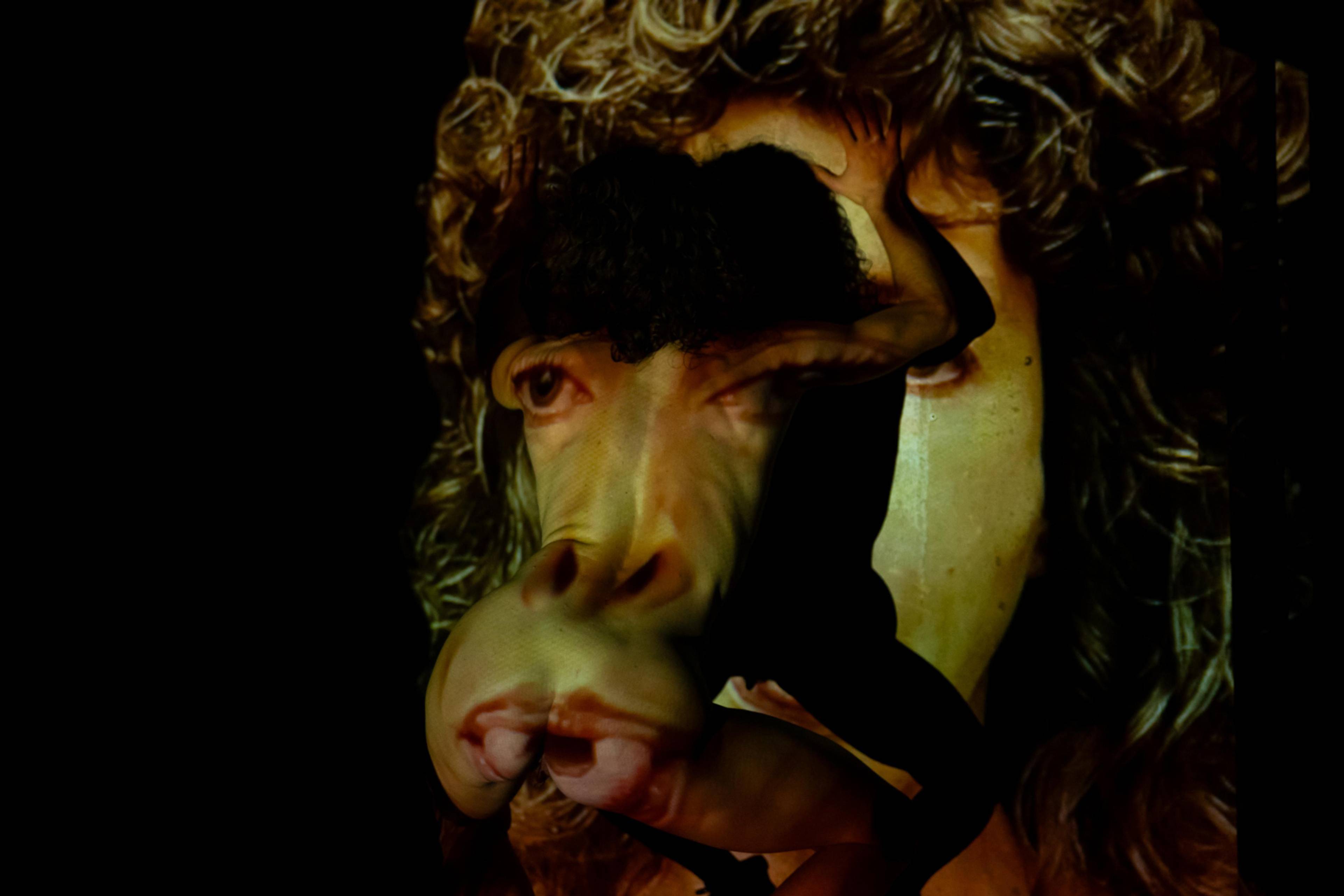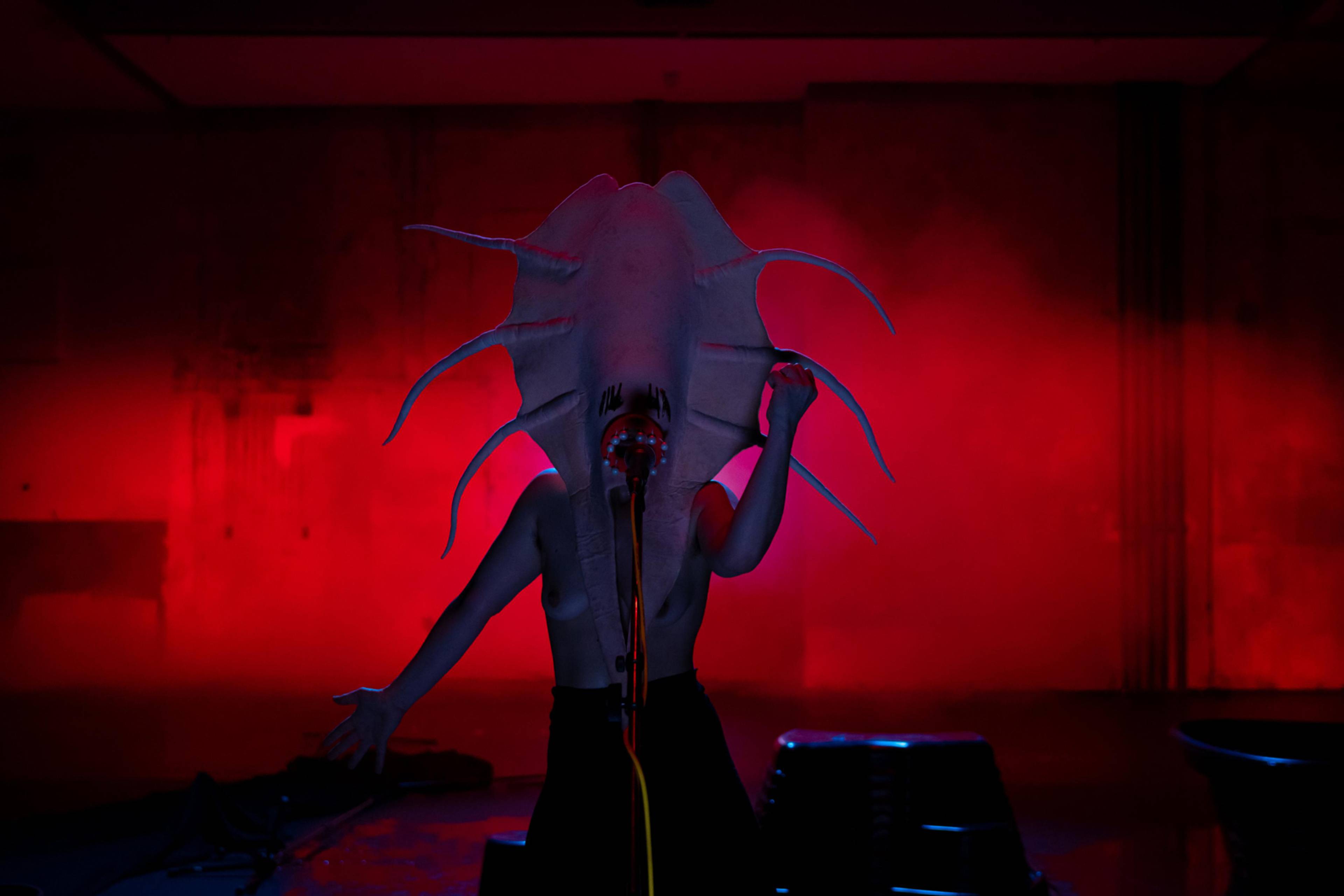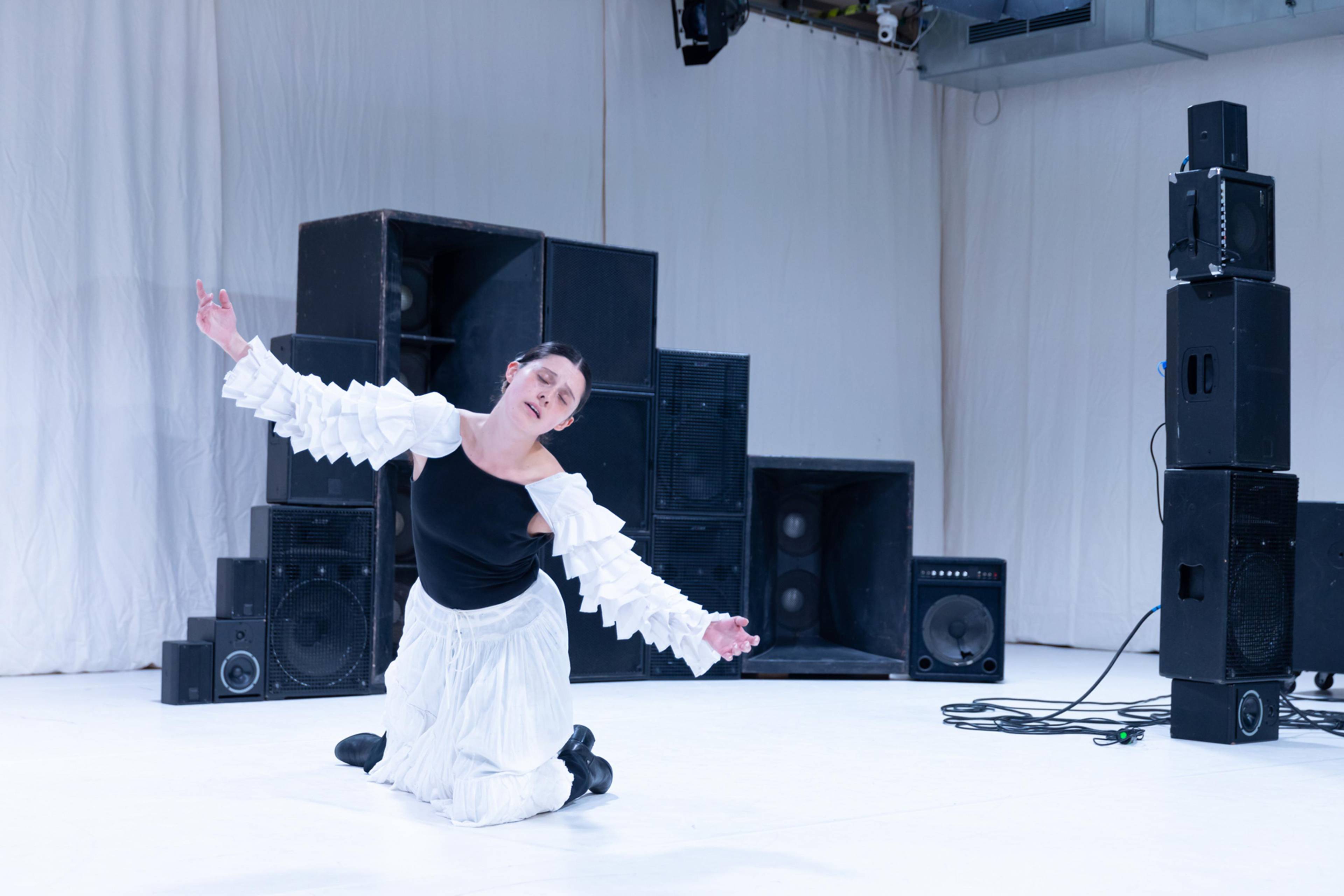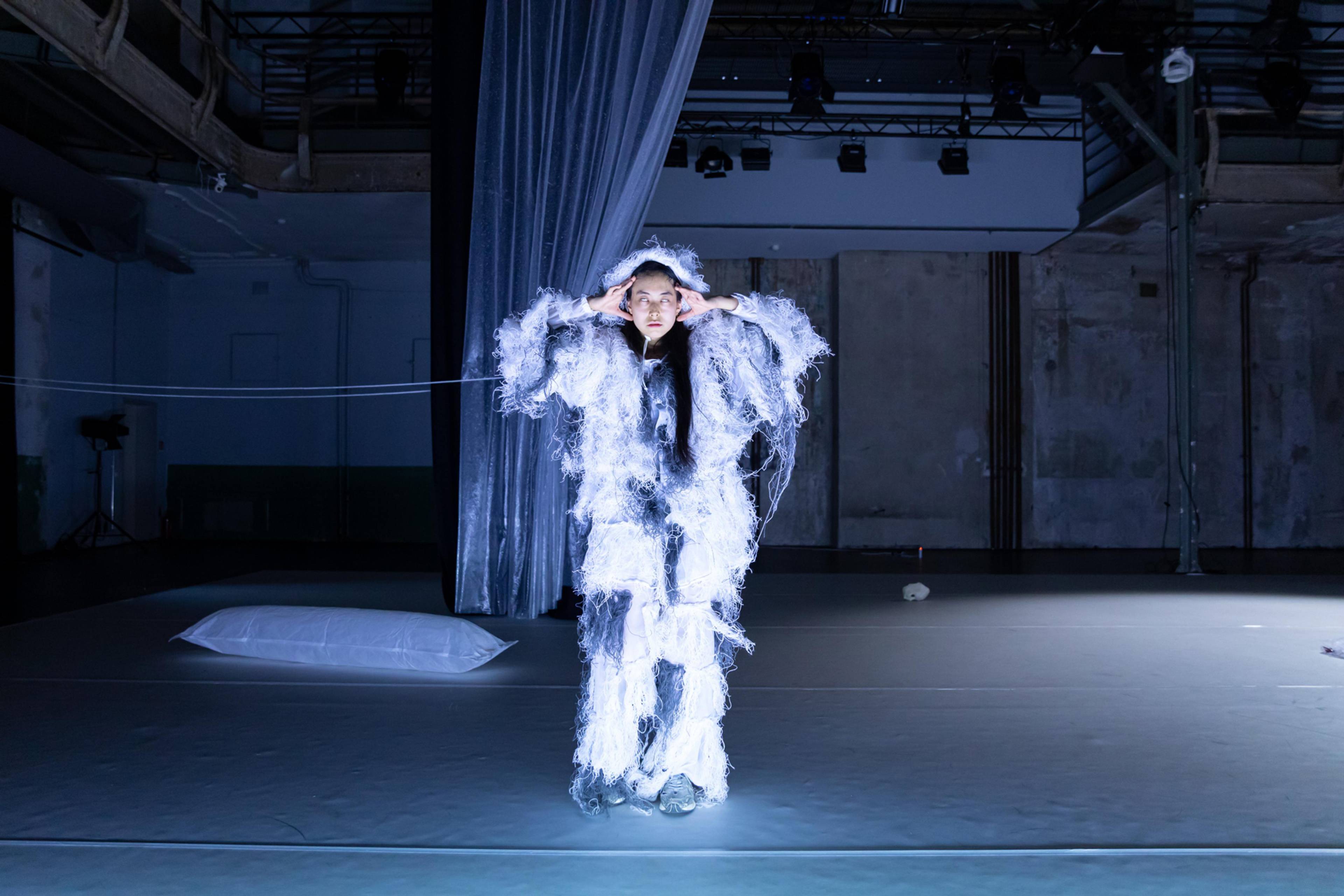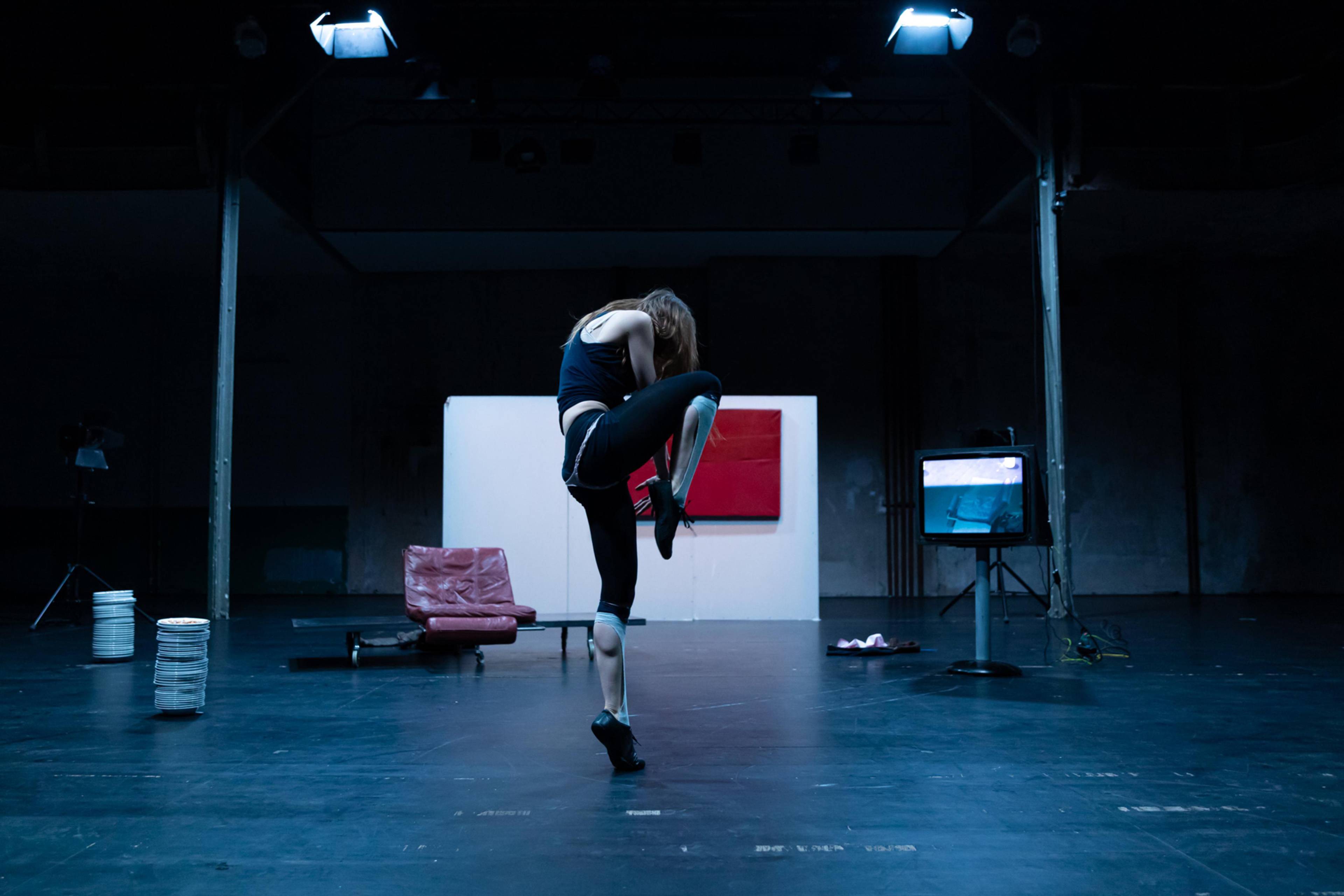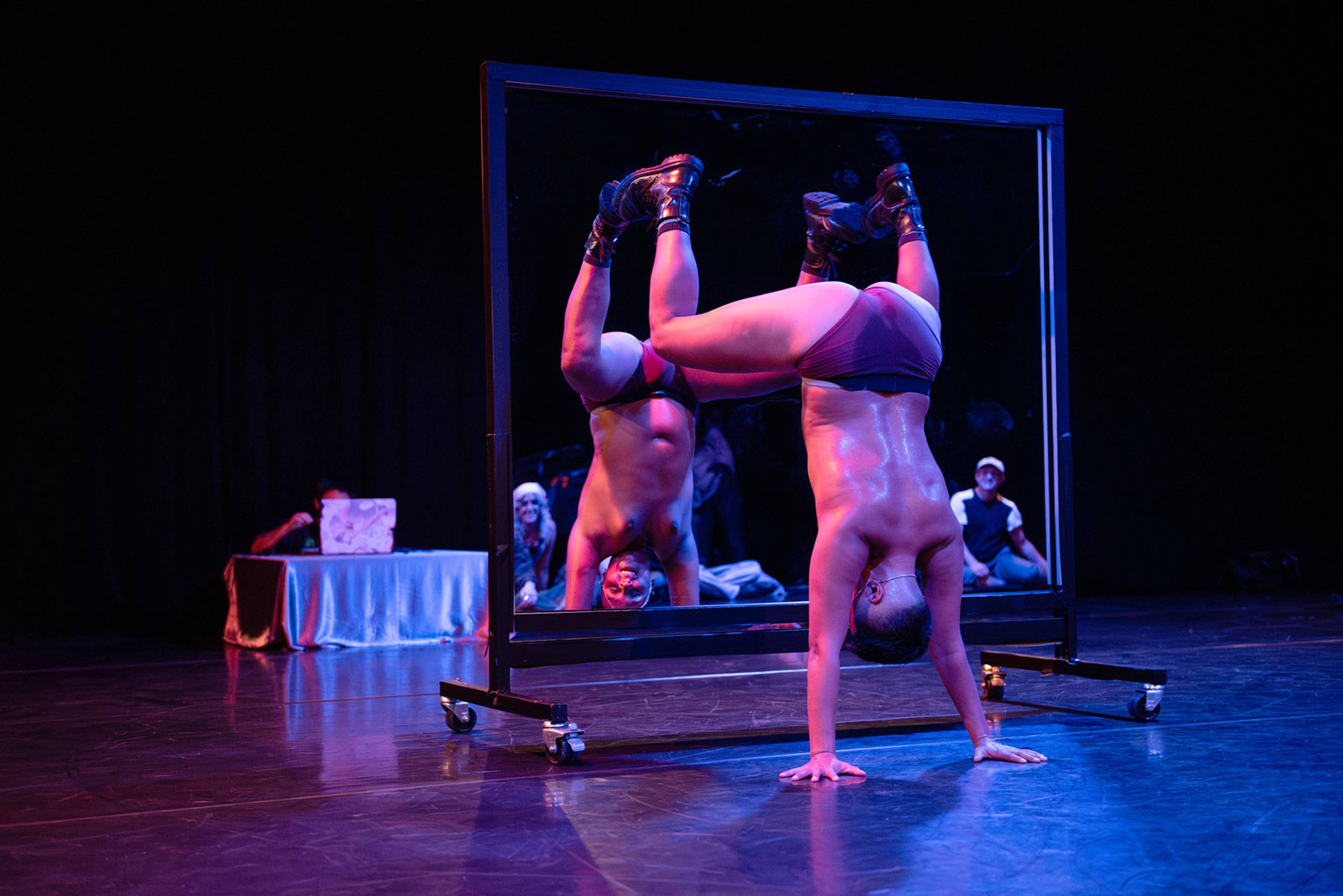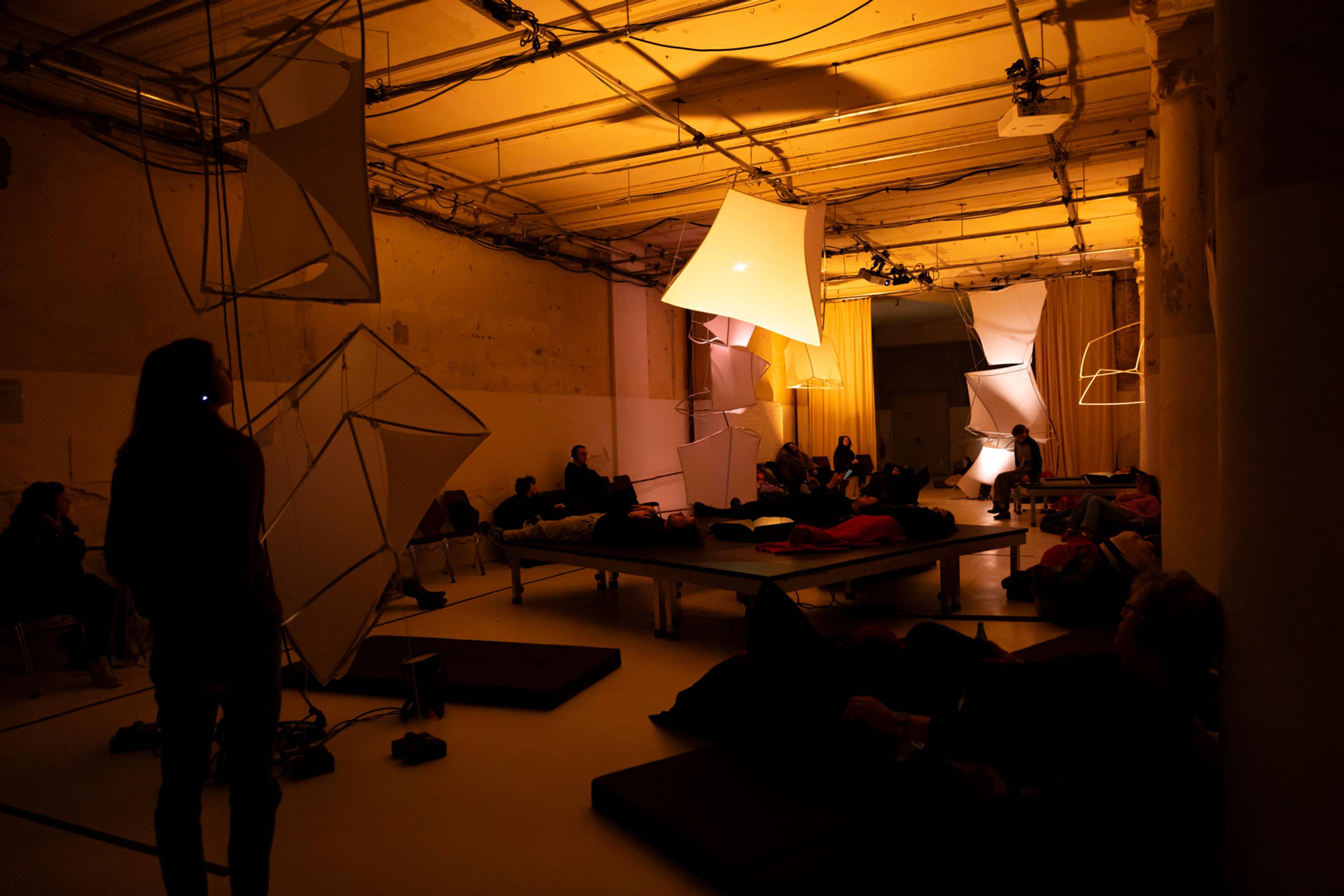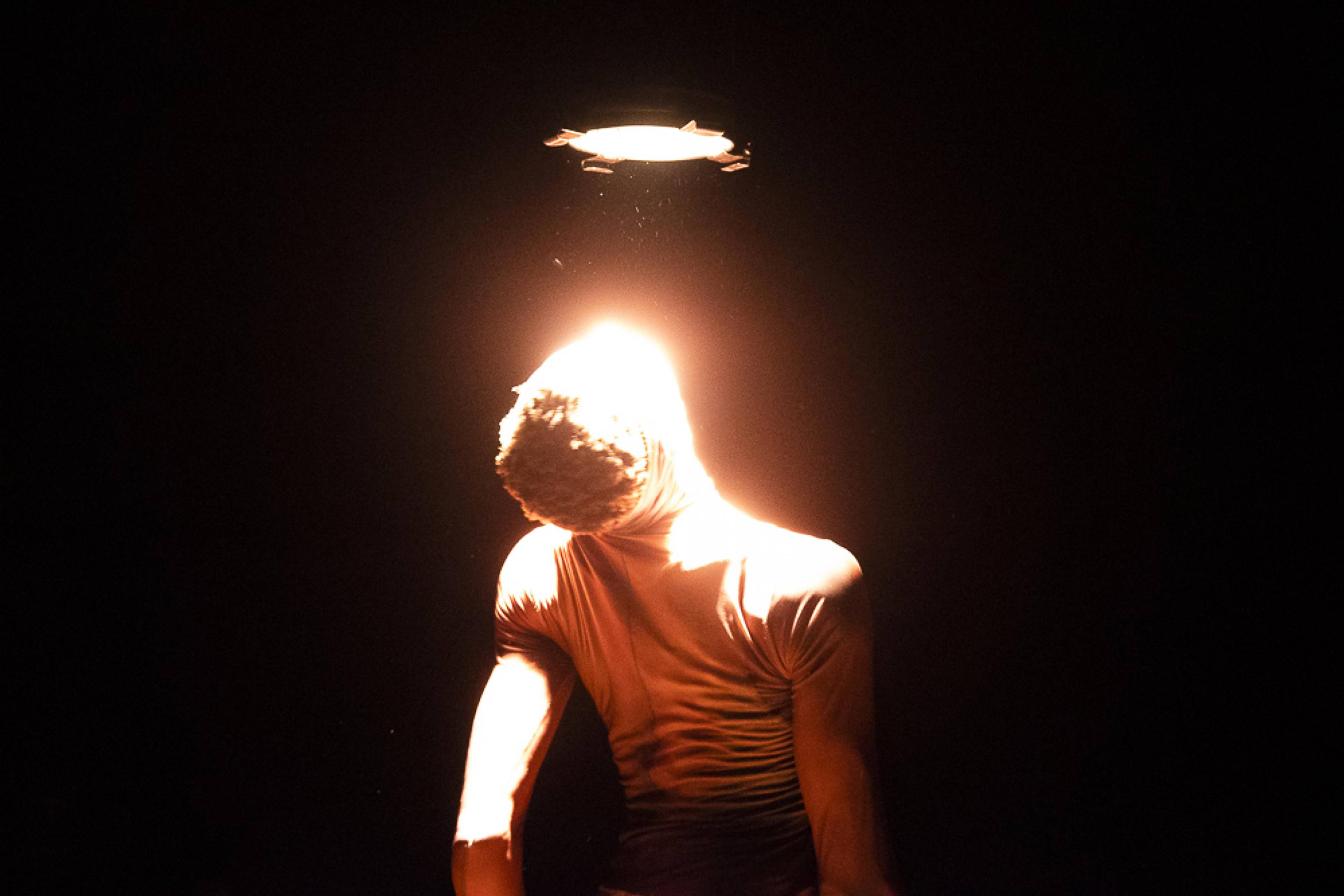The 34th edition of Tanztage Berlin, an annual festival for emerging choreographers at Sophiensæle, occurred amidst acute scarcity and looming collapse. With the Berlin Senate freezing the public budget for 2025 last October, the festival operated with less than half its regular resources. Artistic director Mateusz Szymanówka’s curation of solos, remounts, and scene-focused symposiums dealt, not only with the deficit, but also with body politics, burnout, and liberation, proceeding with resilience and style.
An opening double bill presented WET HOT WOMBS – Bathing into other Bodies by Tentacular Figurings (Mika Bangemann and Eddie von Seckendorff) and Kysy Fischer’s Super Superficial, both recently premiered at the Inter-University Centre for Dance Berlin (HZT). WHW is a solo in which Bangemann reshapes their body with object appendages and prosthetics, fictionalizing to become much – and many – more than human. The opening sequence – staging a pink, fluffy, dexterously animated mound – recalls the octopus plushie that appears throughout Fabrizio Terranova’s documentary Donna Haraway: Story Telling for Earthly Survival (2016). Bangemann echoes iconic musician Peaches with a large headpiece that conjures oyster, vagina, sun, medusa, and scorpion, exaggerating “intra-active” agency and rebellion with vocal blasts: “Body loses the idea of their boundaries. Fuck boundaries.”
Super Superficial opens with the dainty, floating locomotion of a trio of naked women linking limbs, as in Matisse’s 1910 painting La Danse. They compose a photographic stillness and stare blankly outwards. This frozen moment begins to drip, dissolving into new horizons. Beginning with facial mutations and creeping into monstrous expressions – eyes popping, fangs bearing, jaws and tongues stretching – crazed forces spread through their bodies. They kick, twist, contort, and thrash; Manoela Rangel even clambers right up an industrial pillar in Sophiensæle’s Festsaal. A fourth performer, musician Kriton Beyer, plays broad, guttural, voice-like whines on a daxophone (a friction-driven wooden instrument), merging with the cacophony of bodily motion. They fracture the hegemonic gaze through hyperproduction, flooding our visual field with their self-representations.
Tentacular Figurings, WET HOT WOMBS – Bathing into other Bodies
Excess is similarly central to Luisa Fernanda Alfonso’s captivating Masterpiece, also developed at HZT. By representing cultural archetypes from Latin dance and folklore, such as Mariachi, Alfonso engages in “hyper-dramatic, hyper-virtuous, and hyper-gendered” expression, treating these identities as forms of drag. She performs melodramatic duets with numerous audio monitors and amplifiers of different sizes, each playing recordings of Alfonso’s songful voice. She harmonizes with her captured vocals, clutching the devices to her chest or turning them emphatically towards and away from her and us, as if their cries also come from human faces. Several monitors stand in a row at her height, adorned with layered ruffles to match Alfonso’s attire, exquisitely designed by Isabelle Marie Lange. The strength of this meticulously crafted choreography lies in the tension between its candor and its artificiality – donning embodiment and song as playful costumes, flirting with nostalgia as affect rather than performing it as relation, saturating the space in echoes of dispersed expression.
By contrast, Hanako Hayakawa’s Lurker deals with invisible presences and transformations, unsettling the role of the theatre’s “unseen” audience. Through a movement quality between vibration and levity, she slowly drifts through space in a large suit of shaggy fabric, its soft form visually blending into a sparse landscape of miniature lights, inflatables, and a curtain that intermittently obscures her figure. Hayakawa delicately lowers herself to the floor, moving her arms through motions that sometimes form signs; her index and pinkie fingers find devil horns, and her tongue extends. Lurker is sweetly insidious, its situation continuously grounded and ungrounded by imperceptible shifts, which sometimes eventuate into small, whimsical climaxes – moments of collective recognition. The tension in these mundane and paranormal manifestations is magnified when a sizeable, orange, inflatable fish, recalling Philippe Parreno’s fish balloons from 2016 and Andy Warhol’s levitating Silver Clouds from the 1960s, floats nonchalantly into this world of benign yet eerie lurkings.
Luisa Fernanda Alfonso, Masterpiece
Hanako Hayakawa, Lurker
Shade Théret’s Daybreak is a cinematographic psychodrama where a vagabond denies and evades belonging. Inside a sleek, 1990s-esque scenography by art group MRZB (a red leather sofa, a vintage Box TV, piles of stacked, dirty plates) and a gripping, textural soundscape of prepared piano, beats, and grooves by singer, pianist, and producer Rin Suemitsu (aka Golin), Théret tears through angsty movement sequences, messy with emotion. The music and dancing feel at once fresh and esoterically out of time. My gaze moves between Théret and the vintage TV screen streaming the live situation from a hidden camera above, like footage tracking bodies captured from holding rooms or cells. She grabs her hair, rolls her head, takes high-knee steps onto the balls of her feet, pivots, and repeats. Through an endless, tense dawn – a relentless shattering – high kicks, head rolls, and back arches imprint onto the environment of domestic enclosure, her psyche manifestly physicalized.
Auro Orso’s PERREO ENTRE LOS MUNDOS also bursts its performer into many identities. Topless, shrouded in a silicone garment, his body slurps and thuds low among the floor-seated audience, the loose second skin flapping and dragging. An experimental lecture on the neocolonial appropriation of reggaetón music (blending Latin American, Caribbean, and hip-hop influences, deeply tied to perreo dance culture) ruptures the situation. Orso, now standing, brings that legacy into the present, shaking his lone, brown ass in the faces of a mostly white audience. When he disappears behind a curtain, we’re left with Mahya Ketabchi’s robust sound design. I want to get up and dance into this reckoning; many of us are already gyrating. Orso reemerges and performs an exhilarating dance into a large mirror, wearing the silicone flesh as a muscular chest and a G string, giving booty at the back and package at the front. His face is wrapped in a fierce, sparkling wrestling mask. He climaxes into a sensual explosion of popping, swaying, and thrusting, driven by the dembow beat.
Shade Théret, Daybreak
Auro Orso, PERREO ENTRE LOS MUNDOS. Photo: Dijana Zadro
Leo Naomi Baur’s The Disempowered is a meditative installation without live performers. Composed of fragmented surfaces for projection, made elegantly with slim, bending tubes stretching white sheets, I feel like I’m inside a whale skeleton or sailboat scaffolding, recalling Agnès Varda’s LA POINTE COURTE (1955). We enter with headsets and a printed QR code and sit on chairs, platforms, and beanbags. Tea brews. The code leads me to an epic poem, my line reading gradually softening throughout the hour-long immersion.
This is remembering
-Why are you trembling?-
In a photo printed on a large brown paper lies on the floor
A voice sounds in my headphones: slow German, fragmented descriptions. Another joins in English, then another in Syrian Arabic, a murky conversation. The white surfaces around us scatter footage of rocky cliff faces and figures walking backwards, retrograding time, cutting between handheld takes of Berlin’s U-Bahn stations and close-ups of bodies hovering in corridors, possibly a boxing ring. These strange assemblages, splashing on and around us, interplay with sparsely strummed guitar notes and drifting voices, submerging the space into an aquarium. Synesthetic listening, as seeing, as reading, becomes thinking, remembering, sensing, feeling, ideating: flow state.
Fragmented imagination weaves the captivating, unpredictable INTERMISSION by vAL (Corey Scott-Gilbert). This solo is built through spoken word-play and physical utterance, through which he encounters and relays an archive of dreams that morph him through their blurring expressions. Movement and language produce each other, motivated by a dismal, numbed-out perspective on waking reality. His transforming embodiments move him through the scenography of a small, rocky island, photographic silk prints of overlaid faces strung up on a clothesline cutting through the space, and a reflective gold orb high in the corner, like a sun or a moon. Body, image, and object breathe into each other; language reclaims bodily integrity. Rather than strive to communicate legible judgment on modernity’s destructive machines, this work finds refuge in ongoing, relentless practice, epitomizing Tanztage’s own resilience. Since its 1996 founding, the festival has been a vital site for bodily imagination, evolution, and defiance – no small (assets) in an era of austerity and acrimony.
Leo Naomi Baur, The Disempowered
vAL, INTERMISSION. Photo: Nella Aguessy
___
34. Tanztage Berlin 2025
Sophiensæle, Berlin
9 – 25 Jan 2025


